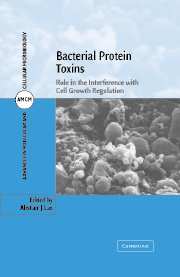Book contents
- Frontmatter
- Contents
- List of Contributors
- Preface
- 1 Toxins and the interaction between bacterium and host
- 2 The mitogenic Pasteurella multocida toxin and cellular signalling
- 3 Rho-activating toxins and growth regulation
- 4 Cytolethal distending toxins: A paradigm for bacterial cyclostatins
- 5 Bartonella signaling and endothelial cell proliferation
- 6 Type III–delivered toxins that target signalling pathways
- 7 Bacterial toxins and bone remodelling
- 8 Helicobacter pylori mechanisms for inducing epithelial cell proliferation
- 9 Bacteria and cancer
- 10 What is there still to learn about bacterial toxins?
- Index
- Plate section
- References
10 - What is there still to learn about bacterial toxins?
Published online by Cambridge University Press: 15 September 2009
- Frontmatter
- Contents
- List of Contributors
- Preface
- 1 Toxins and the interaction between bacterium and host
- 2 The mitogenic Pasteurella multocida toxin and cellular signalling
- 3 Rho-activating toxins and growth regulation
- 4 Cytolethal distending toxins: A paradigm for bacterial cyclostatins
- 5 Bartonella signaling and endothelial cell proliferation
- 6 Type III–delivered toxins that target signalling pathways
- 7 Bacterial toxins and bone remodelling
- 8 Helicobacter pylori mechanisms for inducing epithelial cell proliferation
- 9 Bacteria and cancer
- 10 What is there still to learn about bacterial toxins?
- Index
- Plate section
- References
Summary
The concept that bacteria are rather simple organisms that interact with eukaryotic cells in a passive manner is now totally untenable, as more evidence emerges of active interaction and reaction between bacteria and host. It is also becoming clear that bacterial toxins do not merely operate as molecules of death for a cell. Toxin action may ultimately result in cell death, and indeed death of the host organism, but often the producer bacterium requires that the host cell is first organised in a particular manner. In these circumstances, the toxins sent out by the bacterium on its “behalf” have a mission to regulate the target cell in a very precise manner. Not much is known about the eukaryotic mechanisms that exist to control rather then kill bacteria, but such mechanisms must exist to regulate the homeostatic balance between a eukaryotic host and its commensal bacteria. Furthermore, a host weakened by diseases leading to immunodeficiency, such as HIV/AIDS, stress, or malnutrition, is more susceptible to infection – both by bacteria normally classified as pathogenic, but also by commensal bacteria, which in the circumstances are named as opportunistic pathogens.
Much more is known about the mechanisms that bacteria use to regulate cellular function. Many of these mechanisms have been described in detail in the chapters in this book. Several common themes are appearing. The most frequent targets for such toxins are intracellular proteins involved in the signal transduction pathways that integrate incoming signals at the cell surface.
- Type
- Chapter
- Information
- Bacterial Protein ToxinsRole in the Interference with Cell Growth Regulation, pp. 227 - 230Publisher: Cambridge University PressPrint publication year: 2005

